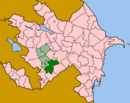Tuğ
Coordinates: 39°35′06″N 46°57′55″E / 39.58500°N 46.96528°E
| Tuğ | |
|---|---|
 Tuğ | |
| Coordinates: 39°35′06″N 46°57′55″E / 39.58500°N 46.96528°E | |
| Country |
De jure De facto |
| Rayon Province |
Khojavend Hadrut Province |
| Time zone | GMT +4 (UTC+4) |
Tuğ (Armenian: Տող, also Togh and Tog) is a village in the Hadrut province of the Republic of Mountainous Karabakh[1] (de jure Khojavend Rayon of Azerbaijan). Today there are 679[2] Armenian villagers, and the villagers and the local government call the village Togh.
In 1906 a village school was opened which today functions as a middle school.[1] A new school was built in 1978, which was renovated for the first time in 2008 by Armenia Fund[3] There is a hospital, a house of culture, a movie theater and a library.[1] In addition to nearby Gtichavank Monastery[1] and the ruins of Gtich Fortress,[1] there are nearby ruins of some churches including Stepanos Nakhavkayi Church of the 13th century.[1] The village church is named Saint Hovhannes and was built in 1736.[1] A few of the Yezanyan Meliks are buried in the yard of Saint Hovhannes Church.[1] In the Middle Ages, the village was the center of the Dizak Melikdom.[1]
In 1974 there were 1,228 Armenian inhabitants in the village,[1] in 1987 there were 396 houses and 1421 Armenian inhabitants.[1]
The village was damaged during the Karabakh War, and lives were lost.[1] Captured by Azeri forces during the war, Armenian forces recaptured the village on October 30, 1991.[4]
Professor M. Yeganyan and Professor Z. Chahangirov are notable people who were born in the village.[1]
References
- ↑ 1.0 1.1 1.2 1.3 1.4 1.5 1.6 1.7 1.8 1.9 1.10 1.11 1.12 (Armenian) T. Kh. Hakobyan, St. T. Melik-Bakhshyan, H. Kh. Barseghyan «Երևան» (Yerevan). Dictionary of Toponymy of Armenia and Adjacent Territories. vol. v. Yerevan, Armenia: Yerevan State University Press, 2001, pp. 117.
- ↑ Results of 2005 census of the Nagorno-Karabakh Republic.
- ↑ Reconstruction of Togh Village School Completed
- ↑ NKR President: Togh Liberation Was Historically Important
| |||||||||||
| ||||||||||||||||||||

